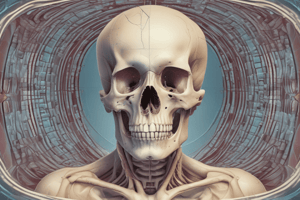Podcast
Questions and Answers
What is the primary design feature of the fourth-generation CT scanners?
What is the primary design feature of the fourth-generation CT scanners?
- Multiple independent detector arrays
- Moving x-ray sources and detectors
- Rotating detectors with a fan-shaped beam
- Fixed detector array with the tube rotating inside (correct)
What impact does the use of an over scan have on fourth-generation scanners?
What impact does the use of an over scan have on fourth-generation scanners?
- Increases radiation dose to the patient (correct)
- Decreases scan time
- Increases image quality
- Reduces motion artifacts
Which statement about third-generation CT systems is true?
Which statement about third-generation CT systems is true?
- They can perform over scans effectively.
- They are the most widely used configuration today. (correct)
- They have a fixed detector array.
- They are known for their superior speed.
How does the radiation dose in fourth-generation scanners compare to third-generation scanners when using the same settings?
How does the radiation dose in fourth-generation scanners compare to third-generation scanners when using the same settings?
What distinguishes electron beam imaging (EBCT) from conventional CT scanners?
What distinguishes electron beam imaging (EBCT) from conventional CT scanners?
What was the primary advantage of electron beam CT (EBCT) when it was first introduced?
What was the primary advantage of electron beam CT (EBCT) when it was first introduced?
What is a disadvantage of the fourth-generation CT system when compared to the third-generation system?
What is a disadvantage of the fourth-generation CT system when compared to the third-generation system?
What often characterizes the image production techniques in fourth-generation scanners?
What often characterizes the image production techniques in fourth-generation scanners?
What primarily distinguishes the first generation of CT scanners from subsequent generations?
What primarily distinguishes the first generation of CT scanners from subsequent generations?
Which design allowed for the x-ray tube and detector both to move in a circular motion within the gantry?
Which design allowed for the x-ray tube and detector both to move in a circular motion within the gantry?
What is a significant disadvantage of the third-generation CT design compared to the fourth-generation design?
What is a significant disadvantage of the third-generation CT design compared to the fourth-generation design?
How does the relationship between the x-ray source and detectors benefit image quality in the third-generation design?
How does the relationship between the x-ray source and detectors benefit image quality in the third-generation design?
What was a limitation of the second-generation CT design compared to the third-generation?
What was a limitation of the second-generation CT design compared to the third-generation?
What technological advancement was made in the third-generation CT design?
What technological advancement was made in the third-generation CT design?
Which characteristic of the first-generation CT scanners contributed to long scan times?
Which characteristic of the first-generation CT scanners contributed to long scan times?
In the context of CT scanner generations, what feature is specific to the design of a fourth-generation scanner?
In the context of CT scanner generations, what feature is specific to the design of a fourth-generation scanner?
Flashcards are hidden until you start studying
Study Notes
CT Scanner Generations
- First Generation: Linear x-ray beam, single detector, slow scan times (obsolete).
- Second Generation: Linear fan-shaped x-ray beam, detector array, faster than first generation but still slow (obsolete).
- Third Generation (Rotate-Rotate): Fan-shaped beam covering entire field of view, detector array rotating with x-ray tube, significantly faster scan times, reduced motion artifacts, highly collimated beam improving image quality, prone to ring artifacts (most widely used).
- Fourth Generation (Rotate-Only): Fixed 360° detector array, rotating x-ray tube producing fan-shaped beam, many detectors but fewer used at once, consecutive readings, more motion artifacts, often uses overscanning ( >360° arc) increasing radiation dose, lower mAs and kVp settings needed compared to third generation.
- Electron Beam CT (EBCT or Ultrafast CT): Electron gun x-ray source, large semicircular anode, no moving parts, very fast scan times, originally suited for cardiac imaging, limited by spatial resolution and clinical versatility.
Other CT Components
- Detector Electronics: Processes signals from detectors to create images.
- Patient Table: Moves patient through scanner gantry.
- Collimator: Restricts x-ray beam size and shape.
- Detectors: Measure x-ray intensity after passing through the patient.
Studying That Suits You
Use AI to generate personalized quizzes and flashcards to suit your learning preferences.




